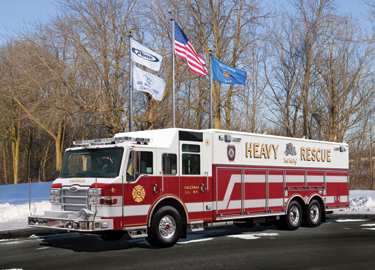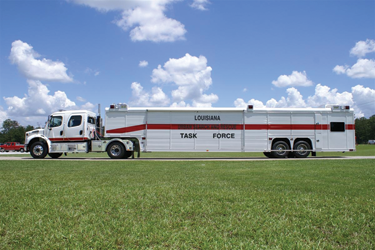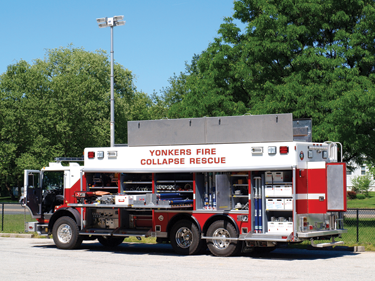Alan M. Petrillo
Urban search and rescue (USAR) is a specialty function for fire and rescue agencies that involves locating, extricating, and providing immediate on-scene medical help to people who have become trapped in confined spaces because of structural collapses; transportation accidents; trench collapses; or natural disasters such as earthquakes, tornados, and hurricanes.
The nature of structural collapse usually means rescuers may be confronted with unstable and uneven debris that can produce numerous voids within the structure, meaning many victims could be trapped under heavy debris that poses stability problems for rescuers.
Because of its specialty nature, USAR requires many different categories of equipment-some of it quite bulky and heavy-to be carried on an emergency vehicle. Dedicated USAR vehicles are built by manufacturers, but most apparatus makers say the greater number of USAR vehicles they build are usually combined with a heavy rescue truck so the vehicle serves a dual purpose.
 |
| (1) Pierce Manufacturing built a USAR heavy rescue on a four-door cab and chassis with a large rear walk-in body for the Hagerman Fire District in East Patchogue, Long Island, New York. (Photo courtesy of Pierce Manufacturing Inc.) |
Heavy Haulers
Kevin Arnold, rescue and specialty vehicle products manager for Ferrara Fire Apparatus, says the company recently built a dedicated USAR vehicle for the Indianapolis (IN) Fire Department on an Igniter chassis with a long cab that had an unusual body arrangement at the rear. “We built a back compartment that went down the center of the truck with a special heavy duty, pull-out, roll-out tray,” Arnold says. “The tray is about 15 feet deep and allows access from two sides and the back to the cribbing, air bags, and rams that would be stored there.”
Arnold notes that for the body of a specialized vehicle, Ferrara will build in any type of material for a customer. “We prefer to work in extruded aluminum because it is the most versatile, but we also build in stainless steel and galvanized steel,” he says.
Ferrara also has built USAR trailers for customers, recently for the Louisiana State Police Task Force. “We designed a fifth wheel vehicle as a huge USAR equipment trailer for them, to be pulled by a tractor truck unit,” Arnold notes. “Each compartment can carry up to 2,300 pounds, instead of the typical 1,500 pounds, because we dropped the frame, allowing 40-inch compartments instead of the usual 28-inch compartments.”
Arnold adds that trailers can usually be built higher than rescue trucks-up to 80 inches high instead of the average 60 inches on a typical rescue truck.
Specialty Equipment Challenge
Andy Yenser, rescue truck product manager for KME, says his company sees fire departments combine the USAR function with heavy rescue operations and apparatus. “We have built USAR vehicles that are used solely for that purpose, but it is costly for the department to have a second vehicle dedicated like that and used infrequently, plus there’s also the issue of staffing the vehicle,” Yenser says.
The most challenging aspect of building a USAR vehicle, Yenser maintains, is getting all the specialty USAR equipment on the truck. “USAR vehicles carry a lot of timbers and ladders,” he points out. “Sometimes it’s difficult to locate that equipment on the truck without hindering other functions of the vehicle. It’s a challenge that has to be worked out.”
Yenser says KME staff members prefer to work with fire department personnel to understand what they are trying to do with the vehicle and how they hope to use it. “That helps us get creative for them,” he says. “We can keep the items they use a lot or those that are very heavy or cumbersome down low for easy access. Likewise, we can place those seldom-used pieces of equipment up high or on top of the vehicle, where it takes extra time to get to them.”
Weight is a critical consideration that a manufacturer must take into account when building a USAR vehicle, Yenser notes. “We look at where and how much heavy equipment will be stored on the vehicle. Once we get an inventory list of equipment, we perform a weight analysis to get the right chassis for the vehicle,” he says. “That design phase is when we work closely with the customer to understand the vehicle’s mission and design a truck that’s most useful to them.”
 |
| (2) Ferrara Fire Apparatus recently delivered a fifth-wheel USAR equipment trailer to the Louisiana State Police Task Force. (Photo courtesy of Ferrara Fire Apparatus.) |
Plan, Plan, Plan
Bill Proft, senior chief engineer and market manager for rescue vehicles at Pierce Manufacturing Company, says Pierce personnel perform a similar routine with customers before a USAR truck is built. “We’ll sit down with the fire department people and ask questions about their needs-walk-in or nonwalk-in vehicle, for instance-as well as the amount of equipment they plan to carry and how they intend to use the vehicle,” Proft says.
Proft notes that when the USAR function is combined with a heavy rescue truck, it can be difficult to precisely define where USAR ends and typical rescue begins. “USAR uses a lot of rescue-related tools you’d see on a standard rescue truck,” he says, “equipment like hydraulic tools, air bags, rams, jacks, and air tools. We also see a lot of timber and wood that’s used as cribbing and shoring, as well as plywood that can be used in trench collapse work.”
The typical USAR-rescue vehicles Pierce has been building during the past year and a half are represented by three main types, according to Proft: two-door cab with walk-in body, four-door cab with walk-in body, and two- or four-door cab with nonwalk-in body. “The two-door cab with a walk-in body seems to be the most popular,” Proft says. “Instead of using crew space behind the cab, rescue personnel can sit in the back of the body, or that area can be used for rehab. It’s also a little easier to climb in and out of than a cab.”
Proft points out that Pierce recently built USAR rescue vehicles on two-door cabs with walk-in bodies for the North Charleston (SC) Fire Department and the Cranston Heights (DE) Volunteer Fire Department.
Pierce also built a four-door cab and large walk-in body USAR-rescue for the Hagerman (NY) Fire District in East Patchogue, Long Island, and a four-door nonwalk-in USAR-rescue with two light towers and a 35-kW generator for the Regional Municipality of Wood Buffalo, in Fort McMurray, Canada.
Typical USAR rescue bodies run between 22 and 26 feet long, Proft notes, and the walk-in models usually include bench seats, heating, and air conditioning in the back, as well as escape hatches in the roof and sometimes even a couple of windows on each side. “Most of the USAR vehicles have a number of winch receivers around the truck,” Proft points out, “typically one in the front bumper and receiver tubes for a portable winch at the rear and one on each side at the fender panels.”
Light towers, lots of scene lighting, a good complement of cord reels, hydraulic tool reels and tools, and a breathing air cascade system are often found on USAR vehicles, Proft says, along with plenty of shoring, plywood, and air struts to allow rescuers to perform collapse and below-grade rescue operations.
 |
| (3) The Yonkers (NY) Fire Department chose Hackney to build this USAR collapse rescue unit on a two-door cab chassis and nonwalk-in body. (Photo courtesy of Hackney.) |
AKA Technical Rescue Trucks
Ed Smith, director of sales and marketing for Hackney, says USAR vehicles are one of the major product lines his company makes. “Often they’re called technical rescue units,” Smith says, “but they’re all designed to carry equipment specially designed for collapses, heavy extrication, trench rescue, and other types of specialty rescue.”
Smith points out that the timber complement on a USAR vehicle is a major requirement. “There’s no such thing as being able to carry enough timber for technical rescue,” he says. “The vehicle must carry enough timber to hold the rescuers on the scene for 20 to 30 minutes. Sometimes departments will contract with a local lumber company to keep a pallet of timber loaded on their premises that could be quickly deployed if necessary.”
Smith says that Hackney has built vehicles that can carry 16-foot-long timbers, along with an assortment of two by four, four by four, and six by six wood, as well as a load of ¾-inch plywood. “A vehicle might carry 22,000 pounds of timber alone,” he observes.
Often a USAR vehicle will have a large-volume air compressor running off of the truck’s PTO, Smith notes. “The most popular is 175 cubic feet per minute (cfm), but some of the trucks go out of here with 375 cfm, which is a lot of air. The department will use it to run jack hammers, high- and low-pressure air bags, and an air knife, which knocks down and siphons away loose dirt and debris.” Besides timber, air bags on a USAR vehicle take up a great deal of space, Smith says, noting that “a USAR complement of air bags is very comprehensive.”
Donley Frederickson, national sales manager for Rosenbauer, agrees that USAR vehicles are typically folded into heavy rescue units. “They usually are combination vehicles,” he says. “The equipment you see on heavy rescues can be used in USAR work along with the specialized USAR equipment.”
 |
| (4) The Braidwood (IL) Fire Department recently took delivery of a 38- foot fifth-wheel USAR trailer made by Alexis Fire Equipment. (Photo courtesy of Alexis Fire Equipment.) |
Trailer Usage
Frederickson says Rosenbauer recently built two USAR rescue trucks for the Dekalb County (GA) Fire Department, as well as 14 tractor trailers and 12 single-axle combination vehicles for the Georgia Emergency Management Agency.
Doug Gau, project manager for Alexis Fire Equipment, says his company has built both trailer-based and truck-type USAR vehicles for customers. “With a trailer, it can either be bumper pulled or a fifth wheel,” Gau says, “and sometimes the USAR function will be combined with another, like a hazmat or confined space vehicle. It’s all a matter of designing the vehicle to accommodate the equipment they need to carry.” Gau says Alexis recently delivered a 38-foot fifth wheel USAR trailer to the Braidwood (IL) Fire Department “that carries a lot of shoring, thin forms, plywood, hydraulic rescue tools, and air bags.”
Alexis also built a USAR rescue truck for the Harlem Roscoe (IL) Fire Protection District on a Freightliner MT55 chassis with a 26-foot Utilimaster walk-in body. “The vehicle has compartments around the exterior with roll-up doors and slide-out drawers for the shoring and air bags,” Gau says. “It carries a 10-kW Onan hydraulic generator, four 750-watt recessed Akron Brass scene lights, a 500-watt Akron Brass brow light, front and rear winch points, and an 18-foot awning.”
Alexis built a specialized compartment into the interior of the Harlem Roscoe rig for storing plywood, rescue jacks, shoring, brooms, shovels, and stabilizers, Gau points out. The interior includes a squad bench, a hot- and cold-water-dispensing system, and an Incinolet electric incinerating toilet.
ALAN M. PETRILLO is a Tucson, Arizona-based freelance writer and is a member of the Fire Apparatus & Emergency Equipment editorial advisory board. He served 22 years with the Verdoy (NY) Fire Department, including in the position of chief.

